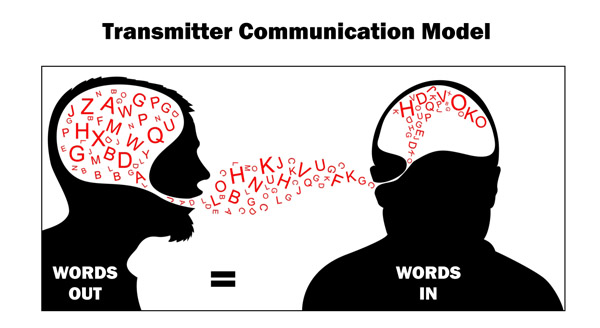 Without really thinking about it, most of us behave as if whatever we say or write in a business communication is received exactly as we intended it by the listener. The illustration at right indicates the usual way that listening is thought of. It is as if we imagine that somehow words magically float from our vocal chords (transmitters) into the ear drums (receptors) of our listeners. We see listening like an equation: words out equal words in.
Without really thinking about it, most of us behave as if whatever we say or write in a business communication is received exactly as we intended it by the listener. The illustration at right indicates the usual way that listening is thought of. It is as if we imagine that somehow words magically float from our vocal chords (transmitters) into the ear drums (receptors) of our listeners. We see listening like an equation: words out equal words in.
If we examine that more closely it becomes obvious how inappropriate such a model is for human beings. We are not passive transmitters or receivers; rather, we are active interpreters of what we hear. I will give you a simple example to demonstrate what I mean.
Imagine a manager starting a meeting by saying, “I have decided to make some changes in this department.” The employees at the meeting could ask, “What kind of changes?” However, someone could hear the manager’s words as a criticism and ask, “Are you dissatisfied with my work?” Someone else might hear it as confrontational and challenge it by saying, “I do not want to change.” Who listened correctly? When you ask a question that implies that there is one “correct” way of listening, you are functioning out of the inappropriate transmitter communication model of words out equal words in. That model is appealing to people because it is easier to act as if there is only one right answer; as if the equation of words out, words in, is true.
Due to a general lack of awareness about the nature of listening, both speakers and listeners are using the same faulty assumptions. Speakers assume that the listener has heard what they said as they intended it. Listeners assume that they have interpreted accurately. In other words, both sides are sure they are right and are convinced that the communication was successfully transmitted. But if a problem arises out of a miscommunication, who is typically blamed for it?
I have noticed over the decades in my work with clients, from a variety of professions and cultures, that we all share something in common; if there is a miscommunication, most of us blame the listener for not listening correctly. I challenge that. Indeed, I challenge the notion of blame itself. If there is a miscommunication, it is not the speaker’s or listener’s fault. Rather, it is due to the fundamental inexactness of using language. Being aware of that, you can change how you listen, especially when using English as a second language.
Speaking always delivers an approximation of what you mean, regardless of what language you speak or what level of competence you have. And listening is always an interpretation, also no matter what language you speak or what level of competence you have. By accepting that reality of speaking and listening, you can see the importance of taking more care and responsibility when communicating within intercultural contexts.
In our own cultures, there is less need for vigilance. That is not because we know the language better but because we have other cues, such as voice tonality, body language and shared values, which can help us navigate the imprecise waters of words. Luckily, within intercultural business communication contexts you can quickly change how you listen. Remind yourself often that the act of speaking and listening is not an equation.
Enregistrer
Enregistrer
Enregistrer
Enregistrer

This is the year you have decided to become a more effective intercultural communicator? Bravo! You can purchase and download my eBook, along with an 80-page workbook. Not sure? Read a free extract. Questions? Just ask.

